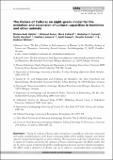Files in this item
The nature of culture : an eight-grade model for the evolution and expansion of cultural capacities in hominins and other animals
Item metadata
| dc.contributor.author | Haidle, M.N. | |
| dc.contributor.author | Bolus, M. | |
| dc.contributor.author | Collard, M. | |
| dc.contributor.author | Conard, N.J. | |
| dc.contributor.author | Garofoli, D. | |
| dc.contributor.author | Lombard, M. | |
| dc.contributor.author | Nowell, A. | |
| dc.contributor.author | Tennie, C. | |
| dc.contributor.author | Whiten, A. | |
| dc.date.accessioned | 2015-08-13T11:10:02Z | |
| dc.date.available | 2015-08-13T11:10:02Z | |
| dc.date.issued | 2015-07-01 | |
| dc.identifier | 209414708 | |
| dc.identifier | 0680cccc-2270-429c-9dbf-97acae633544 | |
| dc.identifier | 84937938392 | |
| dc.identifier | 000361197600004 | |
| dc.identifier.citation | Haidle , M N , Bolus , M , Collard , M , Conard , N J , Garofoli , D , Lombard , M , Nowell , A , Tennie , C & Whiten , A 2015 , ' The nature of culture : an eight-grade model for the evolution and expansion of cultural capacities in hominins and other animals ' , Journal of Anthropological Sciences , vol. 93 , pp. 43-70 . https://doi.org/10.4436/jass.93011 | en |
| dc.identifier.issn | 1827-4765 | |
| dc.identifier.other | ORCID: /0000-0003-2426-5890/work/65014041 | |
| dc.identifier.uri | https://hdl.handle.net/10023/7209 | |
| dc.description.abstract | Tracing the evolution of human culture through time is arguably one of the most controversial and complex scholarly endeavors, and a broad evolutionary analysis of how symbolic, linguistic, and cultural capacities emerged and developed in our species is lacking. Here we present a model that, in broad terms, aims to explain the evolution and portray the expansion of human cultural capacities (the EECC model), that can be used as a point of departure for further multidisciplinary discussion and more detailed investigation. The EECC model is designed to be flexible, and can be refined to accommodate future archaeological, paleoanthropological, genetic or evolutionary psychology/behavioral analyses and discoveries. Our proposed concept of cultural behavior differentiates between empirically traceable behavioral performances and behavioral capacities that are theoretical constructs. Based largely on archaeological data (the ‘black box’ that most directly opens up hominin cultural evolution), and on the extension of observable problem-solution distances, we identify eight grades of cultural capacity. Each of these grades is considered within evolutionarybiological and historical-social trajectories. Importantly, the model does not imply an inevitable progression, but focuses on expansion of cultural capacities based on the integration of earlier achievements. We conclude that there is not a single cultural capacity or a single set of abilities that enabled human culture; rather, several grades of cultural capacity in animals and hominins expanded during our evolution to shape who we are today. | |
| dc.format.extent | 28 | |
| dc.format.extent | 1935894 | |
| dc.language.iso | eng | |
| dc.relation.ispartof | Journal of Anthropological Sciences | en |
| dc.subject | GN Anthropology | en |
| dc.subject | T-NDAS | en |
| dc.subject.lcc | GN | en |
| dc.title | The nature of culture : an eight-grade model for the evolution and expansion of cultural capacities in hominins and other animals | en |
| dc.type | Journal article | en |
| dc.contributor.institution | University of St Andrews. School of Psychology and Neuroscience | en |
| dc.contributor.institution | University of St Andrews. ‘Living Links to Human Evolution’ Research Centre | en |
| dc.contributor.institution | University of St Andrews. Institute of Behavioural and Neural Sciences | en |
| dc.contributor.institution | University of St Andrews. Centre for Social Learning & Cognitive Evolution | en |
| dc.identifier.doi | 10.4436/jass.93011 | |
| dc.description.status | Peer reviewed | en |
This item appears in the following Collection(s)
Items in the St Andrews Research Repository are protected by copyright, with all rights reserved, unless otherwise indicated.

